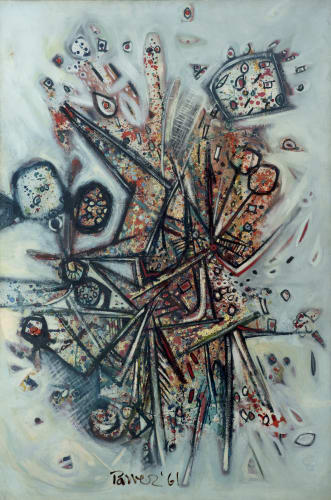Ahmed Parvez was born in Rawalpindi on 7th July 1926. He moved to Srinagar in late 1920s after his parent's separation. There studied at Government Colege for Boys Baramulla, Jammu and Kashmir and later Gordon Collage, Rawalpindi. The family were drawn to artistic pursuits; his grandfather was an architect, his uncle Michael Jacobs had a studio in Lahore and his sister Naz wrote poetry. Parvez was interested in art from a young age, but was discouraged by his family and found employment at a clearing and forwarding agency in Karachi.
In 1952 Parvez left his job and dedicated himself to his passion. He left Karachi for Lahore and moved in to his uncle Jacob's studio where he began his artistic training in European academic style. That year he won the University of Punjab shield for men at the annual All Punjab Art Exhibition, organised by Anna Molka Ahmed, the head of the Fine Arts department at Punjab University.
In Lahore he became part of a circle of young painters known as the 'Lahore Group'. They included Ali Imam, Mariam Habib, Qusida Feroze, Moyene Najmi Sheikh Safdar, Anwar Jalal Shemza and Qutub Sheikh.. The group exhibited together on a number of occasions. Shakir Ali (at the time Head of the Mayo School of Arts), was to become a great influence on the group.
Anna Molka Ahmed and Shakir Ali encouraged the members of the group to travel abroad and expand their horizons. This led to the dispersal of the Lahore Group as many of them left for Europe. Parvez settled on London and arrived there in 1955. In London Parvez's group of friends included Ali Imam, Shemza and FN Souza. In London he met his first wife Rani and they had four children together. It was here Parvez established the 'Pakistan Group' who exhibited together for a short while.
Initially he enjoyed life in London, but gradually Parvez found life difficult in the UK, often prone to bouts of depression, exacerbated by his alcoholism. He spent what little money the family had on painting supplies and drink.
In 1955 his participated in the Sao Paolo Biennale and at Woodstock Gallery in 1958. Exhibitions at Dennis Bowen's New Vision Centre followed. The 1960s Parvez exhibit at the Commonwealth Institute, Lincoln Gallery, London and at Oxford's Ashmolean Museum and Bear Lane Gallery in 1963. This was not enough to satisfy Parvez, and he left London and his family in 1964, returning to Karachi, Pakistan.
In Karachi he met and married his second wife Reiko, with whom he later travelled to New York and had a son with. In Pakistan his work was characterized by brighter colours than his London period, with exhibitions at Bashir Mirza's 'The Gallery'.
In 1966 they moved to New York and in 1968 he had a solo show at Gallery International. By 1969 Parvez was back in Karachi. The next decade was a turbulent mix of exhibitions and erratic behaviour. He was awarded the long-desired President's Pride of Performance Award in 1978, but suffered brain haemorrhage in 1979 and passed away a few days after.
Information taken from Marjorie Husain (ed.), Ahmed Parvez, 2004
